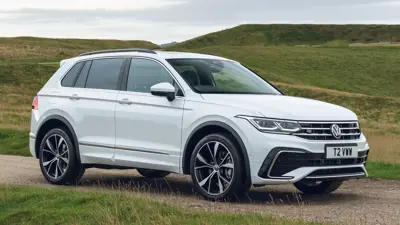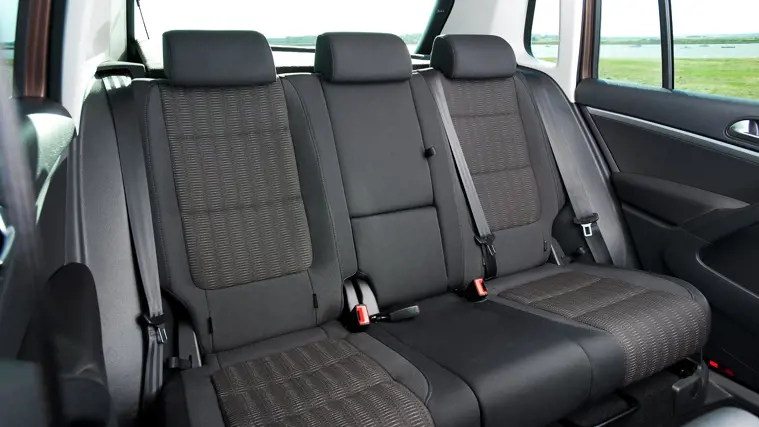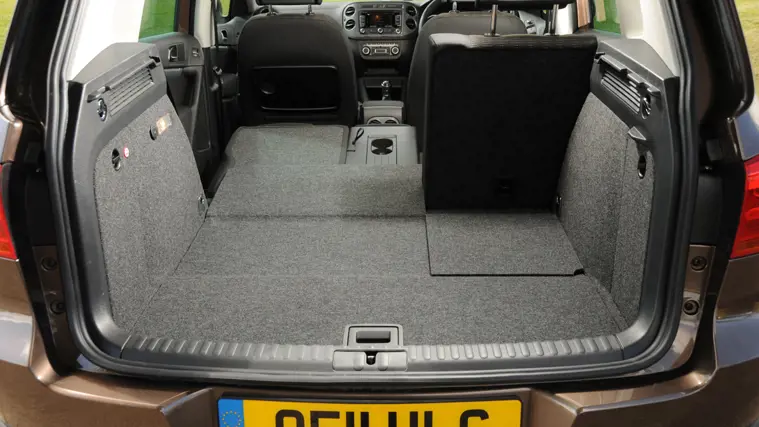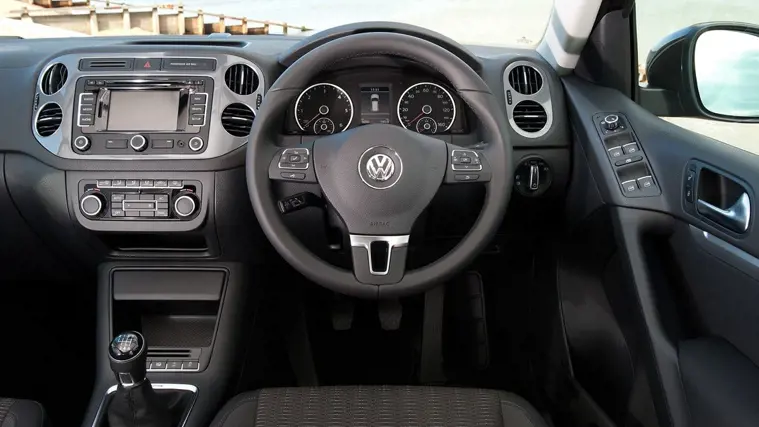Volkswagen Tiguan (2008-2016) Review
Like a Waitrose on wheels, a used Tiguan offers plain sailing for middle class mums and dads
Strengths & weaknesses
- Economical diesel engines
- Interior feels well made
- Slide and divide back seats
- Conservative design
- Some alternatives are more spacious
- Some alternatives feel better to drive
Volkswagen Tiguan prices from £10,341 Finance from £217.41 per month
Volkswagen was slow off the mark when it came to offering drivers a Sport Utility Vehicle, or SUV. Often, however, patience pays off. And in VW’s case, waiting for competitors to make the first move meant the German car maker was able to better understand what buyers both needed and desired before launching the Tiguan, in 2008.
The end result was an SUV that made the middle class target audience feel at home, like pushing a shopping trolley into a branch of Waitrose.
That first generation model, reviewed here, was sold between 2008 and 2016. It offered the usual Volkswagen qualities, namely conservative design, robust build quality (on the surface, at least), an engine range with sensible running costs and a level of space and standard of safety that the young families, or older drivers, that flocked to SUVs demanded.
It wasn’t the most affordable SUV in its class, but now that the latest Tiguan has superseded the first generation model, prices on the used car market range from less than £4000 for the oldest models with the most mileage, to £19,000 for the final models. Along the way, the range had a facelift in 2011.
Built on a Golf platform, anyone that’s driven a Golf should feel at home in a Tiguan. It delivers similar qualities, namely being quiet and comfortable on the road, but never exciting to drive. Then again, that’s what most drivers want from an SUV.
Inside, it will seat four adults in comfort, or, for example, a family of five. The back seat has a sliding mechanism, so that when the 470-litre boot needs to be extended a little without folding down the back seats, it can be shuffled forward. Better still, the seats divide 60/40 and slide independently of one another, making it one of the more versatile cars of its type. With the back seats folded, load space increases to 1510 litres.
These days, the design of the dashboard feels a tad old fashioned compared with the second generation Tiguan, but it’s well made, with the familiar, soft-touch plastics that VW is known for. The driving position has a wide range of adjustment, so those who like to sit low to the floor can, while anyone that prefers a lofty perch can raise it.
Four-wheel drive, called 4 Motion, was initially standard across the engine line up. But before looking for used examples, ask yourself if you need it. After all, the later front-wheel drive models offer plenty of ground clearance and can cope with winter weather or wet fields just fine when fitted with all-season tyres. It could save you a considerable sum, fuel economy is better and there’s less to go wrong.
Needless to say, the diesel models were the most popular, and VW’s proven 2-litre TDI is on duty here. It initially came as a 138bhp unit, but by the end of 2008 a high-powered, 168bhp version was added to the range. The petrol engine line up began with a 1.4-litre, 148bhp unit, before a 2-litre version was added at the end of the year, with 168bhp or 198bhp.
For used car buyers, it will be reassuring to know that the running costs of the Tiguan are sensible, with competitive fuel economy, insurance and affordable servicing. However, the road tax won’t be cheap; the most affordable is £260 a year, while the most potent petrol versions costs a painful £555 a year.
However, the German image of a quality machine is just that – an image. There have been a number of recalls for the Tiguan, and there are some known technical issues, so carefully comb through the service history of any used example.
Of more reassurance is the car’s safety rating. When crash tested by Euro NCAP, in 2007, it was awarded a maximum five-star rating and the child protection rating was four out of five. There are two Isofix mounting points for child seats on the outer rear seats.
Best Volkswagen Tiguan for...
Best for Economy – Volkswagen Tiguan 2.0 TDI 140PS SE
The earlier, 140PS version of the 2-litre diesel engine returned an official combined fuel consumption figure of 53.3mpg. It’s front-wheel drive.
Best for Families – Volkswagen Tiguan 2.0 TDI 140PS SE
Realistically, drivers who want a cost-effective family car needn’t look any further than the 2-litre diesel in front-wheel drive trim. SE trim gives enough gadgets, too.
Best for Performance – Volkswagen Tiguan 2.0 TSI 200PS 4Motion Sport
If it’s speed you want, try the most potent petrol version, which can accelerate from 0-62mph in 7.9 seconds and has a top speed of 130mph. We’d stick with the manual gearbox.
History
February 2008 Tiguan goes on sale in UK.
April 2009 R Line trim level added
May 2009 Two-wheel drive versions of 1.4 TSI 150 and 2.0 TDI 140 engines introduced
July 2011 Facelifted Tiguan range goes on sale
October 2012 R Line trim level returns
August 2013 Match trim level added
Understanding Volkswagen Tiguan names
Engine 2.0 TDI
The 2-litre TDI is a diesel unit and was the best-selling motor in the range. TDI signifies diesel, TSI indicates it’s a petrol engine. When referring to the power of the engine, this is given as 140 PS.
Trim SE
The popular trim level is one above entry-level S
Gearbox DSG
DSG means it has an automatic gearbox
Volkswagen Tiguan Engines
1.4 TSI 150, 2.0 TSI 170, 2.0 TSI 200 petrol; 2.0 TDI 140 and 2.0 TDI 170 diesel
There is some serious food for though for used car buyers when deciding on which Tiguan would best suit their needs. For example those who want to make their money go furthest should note that the entry-level 1.4-litre petrol motor is not as frugal as the equivalent diesel, with fuel economy of 33.6mpg versus 40.9mpg respectively.
Those two engine are also available without 4 Motion four-wheel drive, further helping eek out efficiency gains.
On the other hand, drivers who want added get-up-and-go from their SUV should consider either the 2.0 TSI in 200PS specification, or the 2.0 TDI 170PS. If you don’t intend to cover a lot of miles each year, we’d suggest that the petrol is the pick of those two, because it is so much smoother as it revs, and more enjoyable to use.
However, take note that the most popular version was the 2.0 TDI 140PS. It’s a good all-round performer, pulling from low revs with just enough enthusiasm and returning up to 40mpg with a manual gearbox, or 37mpg when fitted with the optional, DSG six-speed automatic gearbox.
|
Engine |
Fuel |
Economy |
Power |
Acceleration (0-62mph) |
Top speed |
|
1.4 TSI 150PS |
Petrol |
33.6mpg |
148bhp |
9.6sec |
119mph |
|
2.0 TSI 170PS |
Petrol |
31.7mpg |
168bhp |
8.5sec |
125mph |
|
2.0 TSI 200PS |
Petrol |
31.7mpg |
197bhp |
7.9sec |
130mph |
|
2.0 TDI 140PS |
Diesel |
40.9mpg |
138bhp |
10.5sec |
116mph |
|
2.0 TDI 170PS |
Diesel |
40.4mpg |
168bhp |
8.9sec |
125mph |
Volkswagen Tiguan Trims
S, SE, Sport, Escape, R Line, Match
The entry-level trim for the original Tiguan was known as S. It came with just enough goodies to keep drivers comfortable, but the SE was more popular. Those goodies included air conditioning, front and rear electric windows, heated electrically adjustable mirrors, remote central locking, a radio and MP3 compatible CD player and an alarm.
There was also a height-adjustable driver’s seat and multi-adjustable steering wheel, trip computer, and an electronic parking brake. Alloy wheels finish it off, visually.
Step up to the SE and there is tinted glass, roof rails, height and lumbar adjustment for both front seats, a touch-screen audio system, flat-tyre warning system, folding picnic tables for passengers in the back and storage drawers beneath the front seats.
Sport trim is all about giving the car a little more attitude. So it gains front fog lamps, larger, 18 inch alloy wheels, front sports seats, sports suspension, automatic lights and a self-dimming rear-view mirror.
There were quite noticeable differences for Escape models. The bodywork was altered to give the nose of the car more ground clearance, making it better at tackling hills, there was underbody protection, distinct alloy wheels and black roof rails. Engineers also gave the Escape an off-road setting, with hill-descent control and a compass.
All trim levels came with six airbags, anti-lock brakes, a stability control system, five three-point seat belts and two Isofix points in the back for childseats.
Volkswagen Tiguan Reliability and warranty
Only the very last, 2016 Tiguans will have any remaining Volkswagen warranty cover, which was for three-years or 60,000 miles. However, approved used vehicles will come with a year’s cover from VW, and some independent dealers may match this.
Bear in mind that a comparable 2016 Hyundai iX35 will still have two years of warranty remaining, while a Kia Sportage of the same period will be covered up to 100,000 miles and through to 2023 – although the small print calls for careful consideration.
The Tiguan may feel like a robustly made car but owners have not been entirely satisfied. In the 2016 Auto Express Driver Power survey, which asks vehicle owners to rate their car, it finished 92nd out of 150 cars.
Used Volkswagen Tiguan
There are currently 192 Volkswagen Tiguans available on BuyaCar, with prices ranging from £10,341 to £44,900. Monthly finance payments start from £217.41 per month.
Volkswagen’s ‘Das Welt Auto’ approved used car scheme provides a one-year warranty with every used car, along with 12 months’ roadside assistance. There can also be special offers, such as two services free of charge, if buying through VW finance.
Other Editions

Tiguan (2016)
Looking for a big VW Golf with a high driving position? The Volkswagen Tiguan is for you

.jpg?width=759&height=427&format=webp)


.jpg?width=759&height=427&format=webp)

.jpg?width=759&height=427&format=webp)
.jpg?width=759&height=427&format=webp)